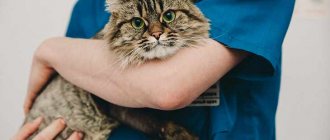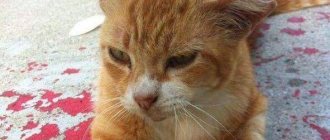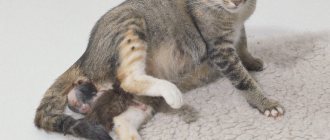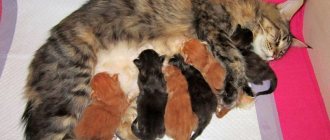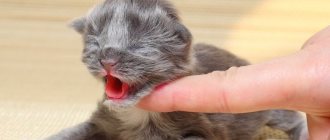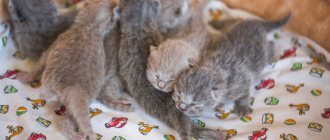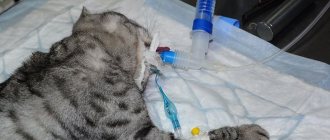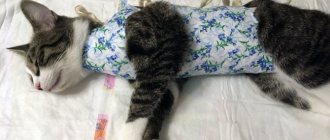Cats are pregnant for approximately 9 weeks. Most often, births in cats proceed safely. Most cats tend to be left alone at this time, so you need to prepare a comfortable place in advance and only periodically visit the young mother during lambing to make sure everything is going well. But it may happen that the animal needs help. In this case, you need to be prepared to provide it yourself or know exactly which veterinary clinic to contact.
How to prepare for lambing of a domestic cat? How to deliver a cat?
In order for the cat to feel as comfortable as possible at the time of the birth of the kittens, prepare a cozy place for her, preferably where there is the least noise and fuss. This could be a small house, basket, box, located at a distance from the TV, draft and battery.
At the end of pregnancy, it is important to visit a veterinarian to make sure that the pregnancy is progressing normally. During this period, representatives of long-haired breeds are recommended to trim the hair in the tail and nipple area.
Particular attention should be paid to feeding the cat. In the last days before lambing, the cat’s stomach cannot stretch to its usual size, so it is important to reduce the portion size, but increase the number of meals.
Another important point is that you need to prepare a set of tools and equipment, which includes surgical gloves, antiseptics, gauze wipes, diapers, pipette, disposable syringes, dental floss, toilet paper, garbage bags and scissors.
When might a cat need your help?
So, the cat gives birth for the first time. You don't know how to help. It is important to understand here that there are signs that directly indicate that the pet needs help. Here they are:
- Part of the kitten has already appeared, but it cannot be born because it is stuck.
- The emerging kitten is not breathing.
- The cat did not release the baby from the amniotic sac.
- If the pet cannot bite the umbilical cord.
- The afterbirth does not come out for a long time.
Precursors of the onset of labor in a cat
The following changes in the cat’s behavior will inform the owner that lambing is approaching:
- Irritability or anxiety appears.
- The animal sets up a bed or looks for a secluded place (hides in closets, behind the sofa, in the closet, etc.).
- The cat often and thoroughly licks its belly and the area under its tail.
- A few days before lambing, most cats produce milk (check this by lightly pressing the nipple).
Important! If there are any deviations from the norm during pregnancy, it is better to entrust the birth to a specialist. The veterinary clinic will be able to provide timely assistance to your cat in case of complications.
How does labor begin in cats? How do cats give birth?
About a day before lambing, a decrease in the animal’s body temperature by about 1-2 degrees is added to the above signs. It is better to accustom your cat to regular temperature measurement in advance.
Immediately before labor begins, the cat begins to breathe rapidly. However, the harbingers are most often unreliable. They cannot always be identified due to the behavioral characteristics of cats - the cat often hides from its owners in any stressful situations, and may not allow the nipples to be probed or the rectal body temperature to be measured.
Most often, the owner notices the onset of labor in a cat during the fetal expulsion phase, which normally takes from 5 to 15 minutes. At this moment, the cat is actively pushing, the amniotic sac appears from the birth canal, or the kitten, which (normally) is fully born during the process of pushing.
How to understand that a cat has given birth to all kittens
Signs that labor has ended:
- the cat begins to actively care for the babies: lick and feed them;
- breathing is calm, heartbeat is regular;
- quite soon after the last kitten has appeared, the animal begins to feel intense hunger and thirst;
- leaves the nest for a short time;
- 30-40 minutes after the last kitten emerges, the belly feels soft to the touch, without compaction.
It should be noted that the abdomen does not always sharply decrease in volume, so its size cannot be an objective indicator of the termination of labor.
If the animal behaves calmly, this may not necessarily indicate that labor has ended. If you have any doubts, it is better to contact your veterinarian and do an ultrasound.
Newborn kittens are completely helpless
If there are suspicions that not all offspring have appeared, you need to pay attention to the behavior. There are a number of signs by which you can determine that the birth process has not completed:
- after the last kitten has appeared, the pet maintains its position, lies in the same position, there are no signs of activity;
- the animal reluctantly and inactively cares for the kittens, does not try to feed them and does not lick them;
- from time to time you can observe attempts; the animal may try to push out another fetus;
- the cat doesn’t want to eat or drink;
- a few hours after the last calf has appeared, the abdomen remains tense, hard, and increased muscle tone is felt;
- a day after the birth of the last kitten, the mother cat’s temperature remains above 39 degrees;
- After two days, bloody discharge with an unpleasant odor appears.
If these signs are observed, there is a high probability that a fetus remains in the uterus. Be sure to call a veterinarian to your home. The best option in this case would be ultrasound diagnostics. Do not ignore the examination, as this can save the animal’s life. However, it is best to prevent such situations and visit the clinic about a week before the expected due date. During the visit, the doctor will perform an ultrasound, and then the owner will have accurate information about how many babies should be born. Then all that remains is to arm yourself with a notepad and pen and write down how many babies and afterbirths have come out.
How does childbirth occur in cats?
There are different stages of labor in both cats and dogs: precursors, uterine contractions, expulsion of the fetus and expulsion of the placenta. The average delivery time without complications is 20-25 hours. The duration depends on the number of kittens. A cat's first labor is usually longer. The second birth and subsequent ones go faster.
Many cats independently rupture the membranes, bite the umbilical cord, lick the kitten, and place the newborn on their stomach. If the cat does not have time or cannot handle each kitten, you need to arm yourself with a rescue kit and help the young mother:
- remove the film from the kitten;
- wipe gently with a sterile cloth;
- tie the umbilical cord with dental floss, then cut it off and treat it with an antiseptic;
- check the kitten's breathing and place it with its mother.
If there is no breathing, you need to clear the airways with a syringe. If breathing does not appear, the kitten should be carefully turned upside down and bent slightly, holding the head. These actions stimulate the outflow of fluid.
Period before childbirth
The pregnancy period for a cat occurs at different times. It depends on the breed and the course of pregnancy. At this time, you will need to monitor your pet's health.
Gestation duration
Cat pregnancy varies in duration. On average it is 62 – 65 days. If pregnancy occurs with complications, it can be from 57 to 70 days. In such situations, it is necessary to consult a doctor and conduct examinations.
Main signs of pregnancy
At 3 weeks you can detect a cat’s pregnancy. The nipples change color, their character changes, nausea and vomiting occur. At week 6, the abdomen increases significantly, the nipples and mammary glands swell greatly.
How does a cat's pregnancy progress?
Sometimes pregnancy can be quite difficult. If your cat latches on quite frequently, loses sociability and appetite, or moans during sleep, you should contact a professional. Complications often occur in purebred breeds.
How to behave with a pregnant cat?
Treat your cat with care. Gently pick her up. If pregnancy is approaching childbirth, then picking it up is no longer recommended. If you accidentally pushed or hit an animal and it scratched you, you should not scold or punish it, as this is a natural process of protecting your offspring.
Complications during childbirth in cats
The saying “only cats give birth quickly” is usually true. But even in cats, the course of labor can be difficult for various reasons:
- Some cats, due to poor health or a violation of the parental instinct, completely ignore the newborn and in this case, removal of the membranes, cleansing the oral cavity of amniotic fluid, cutting and tying the umbilical cord must be carried out by the owners.
- Prolonged labor. If the expulsion phase is prolonged (the cat pushes fruitlessly for half an hour or more), a mechanical problem is most likely. This may be large fetuses, congenital narrowness of the pelvic opening in the mother, abnormal position of the fetus (for example, the fetal head thrown back, bending of the limb, transverse presentation, etc.).
- Generic weakness. Primary birth weakness can be congenital, secondary weakness is more often caused by external causes: exhaustion, systemic disease of the mother, calcium or glucose deficiency in the cat’s body. In this case, stimulation infusions can lead to successful spontaneous labor.
- Weakness of uterine contractions. The cat does not show signs of labor 60 or even 70 days after mating, or labor begins and stops completely after a short time. In case of postmaturity, it is important to monitor the viability of the fetuses, since over time the placenta, through which the kittens receive nutrients, wears out and begins to function worse, leading to intrauterine death and decomposition of the fetuses.
New in blogs
Complications during childbirth in cats. Complications after childbirth.
Complications during childbirth and complications after childbirth in cats are quite common in purebred cats, less often in mixed breeds.
Complications during childbirth in a cat are rarely observed if the animal is healthy and lives in normal conditions. Complications during childbirth occur in small pregnancies, in old-time cats, in sick and obese cats.
Also, complications during childbirth and after childbirth often occur in primiparous, excitable cats.
When you need to urgently call a veterinarian:
- if birth does not occur on time
- if the cat is having strong contractions, but she is unable to give birth within an hour
- if the kitten is visible, but it does not move forward within 30 minutes
- continuous bleeding begins during childbirth and after childbirth
- Temperature suddenly rises or falls. The cat is lethargic and weak
- if labor lasts more than 36 hours
- if after childbirth not all the placenta came out
Indications for caesarean section:
- if the cat is unable to give birth on her own, despite all the measures taken
- with an abnormal structure of the cat’s pelvis, fractures
- when the uterus ruptures or twists
- with a very large fetus
What a cat should not be allowed to do so as not to cause complications during childbirth. - If your cat has a blister sticking out of her vagina, do not allow her to bite through it. This will greatly reduce the kitten's chances of survival. - Do not let the cat run out of the maternity box, especially if there is already a kitten sticking out of it. — If the cat, pushing the kitten out, wants to run away from the pain, grab it tightly by the withers with one hand and put it on its hind legs. In this position it will be more difficult for her to break out and bite you.
Resuscitation of kittens if complications arise during childbirth in cats.
If a kitten was born weak - this is natural selection, you can, of course, try to pull it out, but there is little chance. If the kitten suffered during childbirth, then this has nothing to do with natural selection. A kitten may swallow fluid, get stuck in the birth canal, or be delayed from the pouch, but still be strong, large, and viable. First, the amniotic sac is ruptured in the injured newborn kitten, the fluid is drawn off, then you need to shake the kitten like a thermometer, rub it, and only then give the kitten to the cat. How to draw out the liquid: take the kitten’s body in your hand, clasping the head with your thumb and forefinger, and pull the liquid out of the nose. Then they wipe the kitten’s mouth from mucus with a napkin, open the mouth slightly and take a very light breath into the nose. Important! The mouth must be slightly open to allow excess air to escape. The kitten is then rubbed with a soft cloth and given to the cat. If there is no heartbeat or breathing, rub the kitten quite intensively, but gently in the area of the ribs. If the baby was born without showing signs of life, you need to do the whole complex, only faster and several times in a circle: shake, pull, inhale, rub. And so again and again until the kitten begins to breathe evenly. If a cat gives birth to a kitten with a placenta, then you need to press the umbilical cord from the tummy to the placenta and cut it off at a level of 4-5 cm from the abdomen.
If you notice that your cat has a piece of placenta or umbilical cord sticking out of her vagina, you need to take a cloth and carefully pull it out. Once you have resuscitated and dried the kitten, you need to attach it to the nipple, this will stimulate the cat’s labor.
What to do if the kitten gets stuck at the exit. There is only one way out here - experience, speed and an assistant. If the cat has pinched the baby out of fear and pain, in the area of the neck (when the body is outside and the head is inside), take a cloth, put the cat in the “cat pooping” pose and pull the kitten down by the scruff of the neck, swinging it from side to side, preferably drag him into the fray. The assistant must restrain the cat. Everything needs to be done clearly and very quickly.
Complications in cats after birth:
Mastitis. Mastitis is inflammation of the mammary gland. Occurs as a result of injury, poor hygiene, when there are few kittens, and the cat has a lot of milk. Signs of mastitis: lumps or lumps appear around the juice, the nipple becomes hot to the touch, redder than others, and pain occurs when touched.
Mastitis can be easily prevented by feeling your nipples once a day. If you notice a hard, painful, hot and red nipple, start expressing immediately! The cat may start to struggle and bite, so hold it tight and continue pumping. These steps can prevent mastitis from occurring. Give the cat a subcutaneous injection of Calcium Borluconate 1 ml and Catosal 1 ml. Mastitis often occurs along with attacks of eclampsia. If mastitis has already begun, consult a doctor immediately. It is better to seal the sore nipple. The milk in it is poison for the kitten. In this case, you should never massage the nipple. For mastitis, lubricate the sore nipple with Trauma-gel 2 times a day. Inject Mastomethrin 2 times a day, 1 ml subcutaneously for 5-7 days. Inject Furasemide - 0.2 ml intramuscularly 1 time per day. Steam a cabbage leaf in boiling water, spread it with honey and wrap it with a warm blanket, walk around in the blanket for half an hour until the leaf cools down.
Eclampsia. Eclampsia is milk fever. Eclampsia causes a cat's convulsive state, sudden changes in the psyche, the cat can bite and even eat kittens. Signs of eclampsia in a cat:
- unsteady gait and poor coordination of movements - mastitis
- convulsions - dilated pupils - obsessive states: the cat bites the kittens, drags them from place to place, as if afraid of something. - a sharp decrease in body temperature - the cat is very excited. Either she is wildly terrified, or abnormally cheerful. For eclampsia: - Urgently inject the cat with 1.5 ml of calcium borgluconate (preferably warmed intramuscularly, but you can also subcutaneously), and 3 ml of Gamavit and quickly see a doctor. — If a cat starts biting and dragging kittens, you need to isolate it from the kittens. — It is necessary to carefully examine the cat for mastitis. Treatment of eclampsia: - Calcium borluconate; — Katozal; — Cardiac and sedative; All doses and medications must be prescribed by a doctor.
To prevent eclampsia, some use Caforsen (inject subcutaneously once a day for 2-3 weeks after birth)
Maternal behavior disorder in cats.
Some cats may lack maternal instinct. You need to be close to such a cat. Forcibly attach the kittens and hold it while they suckle.
This usually happens in nervous people. Cowardly, easily excitable. Scared cats.
To reduce your cat's emotional arousal, inject it with Fospasim (it is completely safe for cats and kittens). Inject 1 ml subcutaneously 1-2 times a day for 7-10 days.
Hypogalactia in cats.
Complete lack of milk in a nursing cat. Occurs due to increased secretion of adrenaline, during exhaustion, mastitis. Hypogalactia is possible due to insufficient calorie food. This affects the second week after birth, when the cat needs the most high-calorie food.
Ovariovit perfectly restores lactation. Injected subcutaneously 1-2 times a day 3-4 times a week.
Different blood type. Sometimes it happens that kittens born completely healthy begin to lose weight and die. Some kittens turn yellow before death and their tail tip atrophies. This occurs as a result of a mismatch in the blood types of the cat and the male cat. In some cases, different blood types between male and female cats lead to miscarriages. In this situation, kittens urgently need to find another cat - a nurse or transfer to artificial feeding. The milk of such a mother is poison for kittens.
Fading kitten syndrome.
Occurs with kittens from one day to three weeks. Rarely affects kittens under one month of age. A completely normal kitten suddenly begins to lose weight, become lethargic, and its body temperature decreases. Fading kitten syndrome often occurs with mild inbreeding. And with closer inbreeding - less often. This syndrome is a death sentence for the baby. The body refuses to produce the enzymes necessary for the absorption of milk and the baby dies of hunger, despite the fact that he continues to suckle the cat. It is necessary, even if the causes of death were clear, to autopsy the kitten! It's very difficult, but it can save the lives of the remaining kittens and prevent similar problems in the future.
source of article complications during cat birth
What to do if there are complications during childbirth in a cat?
If you notice any deviations from the normal course of labor, the cat should be taken to a veterinary clinic as soon as possible. Due to the temperamental characteristics of cats, almost all cases of dystocia (impaired labor) associated with mechanical causes end in caesarean section. The fetus, located in the birth canal and unable to come out, experiences acute oxygen starvation, so a cesarean section in such a case must be performed as quickly as possible.
